🫁 Cell Organelles
Learn about cellular organelles
Mitochondria
- ‘Power house of cell’.
- Energy is generated as
ATP. ATP is known as ‘Energy currency’. - Mitochondria was firstly identified by
Altmanin 1886 as `Bioplast’ and suggested their association with respiration. - The term ‘mitochondria’ has been given by
C. Benda(1898).

- Matrix of Mitochondria is the site of
aerobic respirationorKrebs cycle. - Site of glycolysis:
Hyaloplasm(not cytoplasm) - Electron transport: Oxysome/F1 particle/Elementary particle.
- Enzymes confined in Peri-mitochondrial space and reactions on inner membrane.
- Mitochondria contain DNA, RNA (0.02% DNA, 3-4% RNA) & ribosomes.
- Hence called ‘semi-autonomous’ body of the cell because of capability of some protein synthesis.
Plastids
- According to Schimper (1885)
- Green coloured plastids are called
chloroplasts - Red, Yellow, Brown, Orange →
Chromoplast(Chromo means Coloured) - Colourless:
Leucoplasts. The main Function of leucoplasts is food storage.
- Green coloured plastids are called
Leucoplast
- Amyloplast: Storage of
Starch - Elaioplast: Storage of
Oils - Aleuronoplast or Proteinoplast: Storage of
Protein
Chlorophyll
- Chloroplast contains pigment chlorophyll
- Chlorophyll a: Blue black, C55H72O5N4Mg
- Chlorophyll b: Green black, C55H70O6N4Mg
- Carotene: Yellowish Orange, C40 H56
- Xanthophyll: Yellow, C40 H56 O2
- Chl. a & Chl. b in green plants: 65%
- Xanthophyll → Yellow, 29%
- Carotene → Red, 6%
- Carotene & Xanthophyll are together called
carotenoid pigment. - In chromoplast, only carotenoid pigments are found.
Plant pigments
- Plastid pigments e.g. chlorophyll, carotenoids; such pigments are soluble in organic solutions only. Found in leaves & skin of fruits.
- Sap pigments: Solution of salts & sugars found in vacuoles e.g.
Anthocyanin(soluble in water) found in flower petals & beets.
Chloroplasts
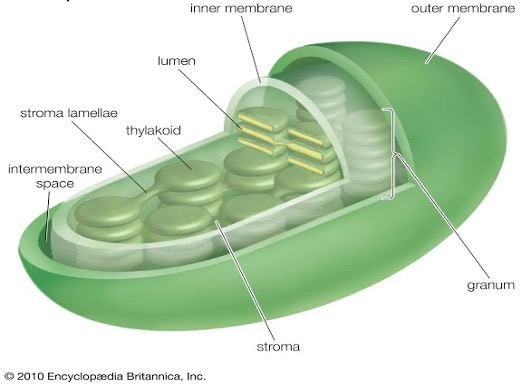
Grana lamellae
- Thylakoids → Quantasomes contain pigment
- Lamellae means membranous tubes.
- Site of Light reaction: Grana/thylacoids/quantasomes → Chlorophyll
- Site of Dark reaction: Stroma/matrix →
RuBISCO - Chloroplast contains DNA (0.5%), RNA (3-4%) and ribosomes (70s). Therefore chloroplast is capable of some independent protein synthesis hence called semi-autonomous body of the cell.
- A plastid has two distinct regions viz. grana & stroma.
- Grans are stacks of membrane bound, flattened, discoid sacs containing chlorophyll molecules. Such molecules are responsible for the food production, hence called the kitchen of the cell.
- The homogenous matrix in which grana are embedded is known as stroma.
Endoplasmic Reticulum (ER)
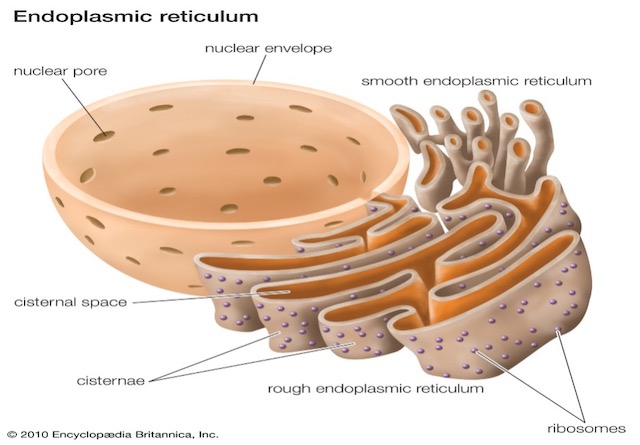
- Endoplasmic Reticulum is a dense network of double membrane (unit membrane) structures running through the cytoplasm.
- It may be continuous, some parts are connected to the nuclear membrane while others are connected to the plasma membrane especially in animals.
- Its origin is from nuclear membranes.
- Ultrastructure of ER was first reported by Porter (1948).
- It is not a stable structure.
- It is capable of being broken down and reconstructed.
- It undergoes partial fragmentation at the time of cell division.
- Two types of ER
- Rough ER (RER): When ribosomes are attached on it.
- Smooth ER (SER): No ribosomes are attached on its surface.
Function
- ER forms endoskeleton to provide a particular shape to the cell (mechanical support), especially in animals.
- Membranes of ER provide the surface for the increased metabolic reaction.
- Intracellular transport of metabolic products or molecules (e.g. protein).
- It helps in the formation of cell plate and nuclear membrane during cell division.
- Synthesis of protein on ribosomes means Rough ER is associated with the protein synthesis.
- Smooth ER (SER) secretes lipids which along with proteins constitute cell membrane by a process called membrane biogenesis.
- Transmission of impulses in animals.
- SER plays a crucial role in detoxifying many poisons & drugs.
Ribosomes/RNA particles
- Consists of r-RNA (ribosomal RNA) 60-40% & Protein 40-60%.
- First observed by Claude (1943) but reported as ‘microsomes’ (ER fragments + ribosomes). Palade (1956) isolated the ribosomes and reported their detailed ultra-structure.
- The term ‘ribosomes’ by R.B. Robert (1958).
Types of RNA (non-genetic)**
- m-RNA (messenger): 5-10% of total RNA
- t-RNA (transfer) / soluble RNA (sRNA): 10-15% of total RNA, Smallest in size.
- Clover leaf model.
- m-RNA and t-RNA directly take part in protein synthesis.
- r-RNA: provides site for protein synthesis.
- 80% of total RNA,
Most stable RNA.
- 80% of total RNA,
- Two major steps are involved in protein synthesis:
Transcriptioni.e. transfer of genetic information from DNA to mRNA.Translationi.e. translation of the language of nucleic acids into that of proteins.
- A ribosome has two subunits, one is smaller and other is bigger.
- In bacterial cells & chloroplasts of higher plants, sedimentation coefficient (S) of complete ribosome is
70 Swhich has subunits 50 S and 30 S. - In higher organisms sedimentation coefficient of ribosomes is
80 Swhich has subunits 60 S & 40 S.- Higher concentration of Mg++ ion promotes association of subunits into complete ribosome.
- Lower concentration of Mg++ dissociates these subunits.
- There is no lipid content in ribosomes.
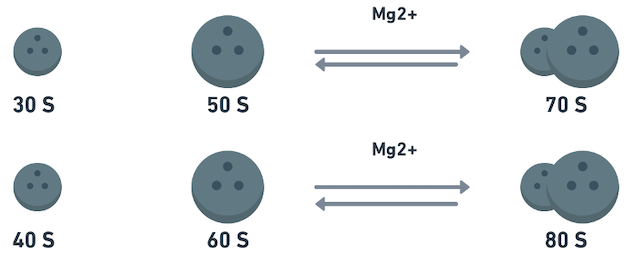
Golgibody/Dictyosome
- Discovered by Camillo Golgi (1898).
- Golgi complex or bodies are formed by stacks of flattened (saucer-shaped) membranes.
- Flattened sacks are called cisternae. Golgi bodies are usually called dictyosomes in plants.
- Its origin from ER.
- ‘Acrosomes’ are associated with Golgi complex.

Functions
- They store, modify, package and condense the protein synthesized in the ribosomes.
- They form the cell plate during cell division.
- They add sugars to some proteins and synthesize some polysaccharides for the cell membrane.
- They set aside digestive enzymes in tiny membrane bound vesicles which become ‘lysosomes’.

Lysosome
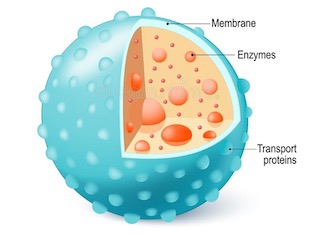
- Lysis means digestion; Soma means body.
- The saclike, small, spherical, single membrane bound vesicles containing digestive enzymes are called lysosomes.
- These enzymes are synthesized in RER which are brought to the ‘Golgi Complex’.
- Lysosomes are formed directly from Golgi complex & indirectly from ER.
- Lysosomes are discovered by De Duve (1955);
mainly found in animalsbut also in some plants like Neurospora. - In animals, epithelial cells of the intestine, kidney cells rich in lysosomes.
Functions
- Intracellular digestion. They help in breaking down (digesting) large molecules of cell.
- They work in defense against bacteria & virus.
- During starvation, lysosomes act on their own cellular organelles & digest them. This result in cell death hence are called ‘
suicidal bag’ or demolition squads means cell autolysis or autophagy.
Spherosomes
- Single membrane bounded mainly in plants.
- Its function is
fat metabolism.
Microsome
- Microsomes are the structures formed when cells are broken up in the laboratory.
- Differential centrifugation can be used to separate them from other cellular debris.
- They are used to imitate the activity of the endoplasmic reticulum in a test tube.
- They are also used to perform experiments that require protein synthesis on a membrane thus aiding in understanding the process of protein formation on the endoplasmic reticulum.
Vacuole

- Important structure in
plant cell. - They may occupy upto 90% of the cell volume.
- Single membrane bound and contain cell sap.
- Function: Osmo-regulation of molecules.
Tonoplastis the membrane of vacuole.
Plasmodesmata
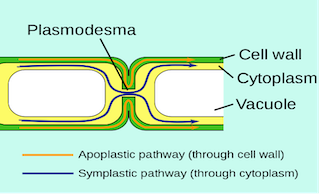
- Found in
plantsonly. - First observed and named by Strasburger (1903) in the form of cytoplasmic strands that connects the protoplast of adjacent cell.
- Origin: from ER
- Function: Provide metabolic contacts between cells e.g. companion cells.
Centrosome
- Present near nucleus,
present in all animal cellsand also in Chlamydomonas, some fungi, Gymnosperms etc. - Two centrioles in one centrosome.
- At the time of mitosis, move to opposite pole and produce astral rays.
- The microtubules of the spindle originate from centrosome during mitosis in both plant and animal cells.
Ergastic Substances
- Non-living cell inclusions e.g. starch, sugar, organic acid, fats, oils, pigments etc.
https://www.youtube.com/watch?v=URUJD5NEXC8 https://www.youtube.com/watch?v=rKS-vvhMV6E
Mitochondria
- ‘Power house of cell’.
- Energy is generated as
ATP. ATP is known as ‘Energy currency’. - Mitochondria was firstly identified by
Altmanin 1886 as `Bioplast’ and suggested their association with respiration. - The term ‘mitochondria’ has been given by
C. Benda(1898).

- Matrix of Mitochondria is the site of
aerobic respirationorKrebs cycle. - Site of glycolysis:
Hyaloplasm(not cytoplasm) - Electron transport: Oxysome/F1 particle/Elementary particle.
- Enzymes confined in Peri-mitochondrial space and reactions on inner membrane.
- Mitochondria contain DNA, RNA (0.02% DNA, 3-4% RNA) & ribosomes.
- Hence called ‘semi-autonomous’ body of the cell because of capability of some protein synthesis.
Plastids
- According to Schimper (1885) …
Become Successful With AgriDots
Learn the essential skills for getting a seat in the Exam with
🦄 You are a pro member!
Only use this page if purchasing a gift or enterprise account
Plan
Rs
- Unlimited access to PRO courses
- Quizzes with hand-picked meme prizes
- Invite to private Discord chat
- Free Sticker emailed
Lifetime
Rs
1,499
once
- All PRO-tier benefits
- Single payment, lifetime access
- 4,200 bonus xp points
- Next Level
T-shirt shipped worldwide

Yo! You just found a 20% discount using 👉 EASTEREGG

High-quality fitted cotton shirt produced by Next Level Apparel